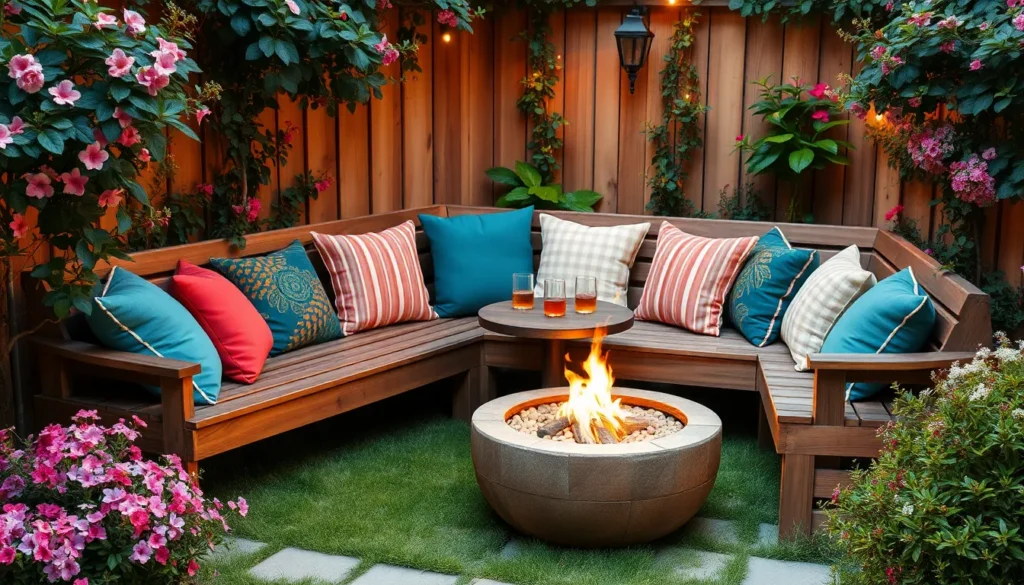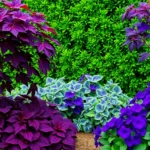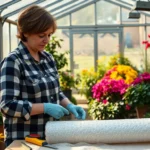We’ve all walked through our gardens and noticed those awkward corner spaces that seem impossible to use effectively. These forgotten areas often become catch-alls for garden tools or simply remain empty while the rest of our outdoor space gets all the attention. But what if we told you these corners could become the most charming and functional spots in your entire garden?
Garden corner seating transforms neglected spaces into cozy retreats where you can enjoy your morning coffee watch the sunrise or unwind after a long day. Whether you’re working with a tiny urban balcony corner or a sprawling backyard nook these spaces offer unique opportunities to create intimate gathering spots that feel both private and connected to nature.
From built-in bench designs that maximize storage to creative curved seating arrangements that follow your garden’s natural flow we’ll explore innovative answers that turn every corner into a destination. Let’s discover how to make these overlooked spaces the highlight of your outdoor living area.
Create a Cozy Corner Bench With Built-In Storage
Building a corner bench with integrated storage transforms neglected garden spaces into highly functional seating areas. We can maximize both comfort and utility by incorporating smart design elements that serve multiple purposes.
Choose Weather-Resistant Materials
Selecting durable materials ensures our corner bench withstands outdoor elements year-round. Cedar naturally resists moisture and insects while developing an attractive silver patina over time. Teak offers exceptional longevity with minimal maintenance requirements, though it comes at a higher price point. Composite lumber combines wood fibers with recycled plastic to create boards that won’t warp, crack, or fade.
Aluminum frames provide lightweight strength and rust resistance for modern garden aesthetics. Powder-coated steel offers superior durability when properly treated against corrosion. Marine-grade stainless steel hardware prevents rust and maintains structural integrity in humid climates.
| Material | Durability (Years) | Maintenance Level | Cost Range |
|---|---|---|---|
| Cedar | 15-20 | Low | $$ |
| Teak | 25+ | Very Low | $$$$ |
| Composite | 20-25 | Minimal | $$$ |
| Aluminum | 20+ | Low | $$$ |
Add Cushions and Throw Pillows
Cushions transform hard bench surfaces into comfortable seating that invites extended relaxation. Outdoor fabric cushions resist fading, mildew, and water damage while maintaining their shape season after season. Sunbrella and similar performance fabrics offer hundreds of color and pattern options to match any garden style.
Quick-dry foam cores prevent water retention and speed up drying time after rain showers. Zippered covers allow easy removal for washing and seasonal storage. We recommend choosing neutral base colors like beige or gray, then adding colorful throw pillows for seasonal variety.
Throw pillows create layers of comfort and visual interest without major investment. Weather-resistant pillow inserts maintain their loft better than standard polyester fill. Consider varying sizes from 16-inch to 20-inch squares for optimal visual balance.
Incorporate Hidden Storage Compartments
Hidden storage compartments maximize our corner bench’s functionality without compromising its aesthetic appeal. Hinged seat tops create spacious storage for garden tools, cushions, and outdoor entertaining supplies. Piano hinges distribute weight evenly and prevent sagging over time.
Waterproof storage boxes protect contents from moisture and pests. Cedar-lined compartments naturally repel insects while adding pleasant fragrance. We can install soft-close hinges to prevent slamming and extend hardware lifespan.
Side compartments with discrete doors offer additional storage without affecting seating comfort. Magnetic catches keep doors securely closed while remaining easy to open. Internal dividers organize smaller items like garden gloves, seed packets, and hand tools for quick access.
Design an L-Shaped Seating Arrangement
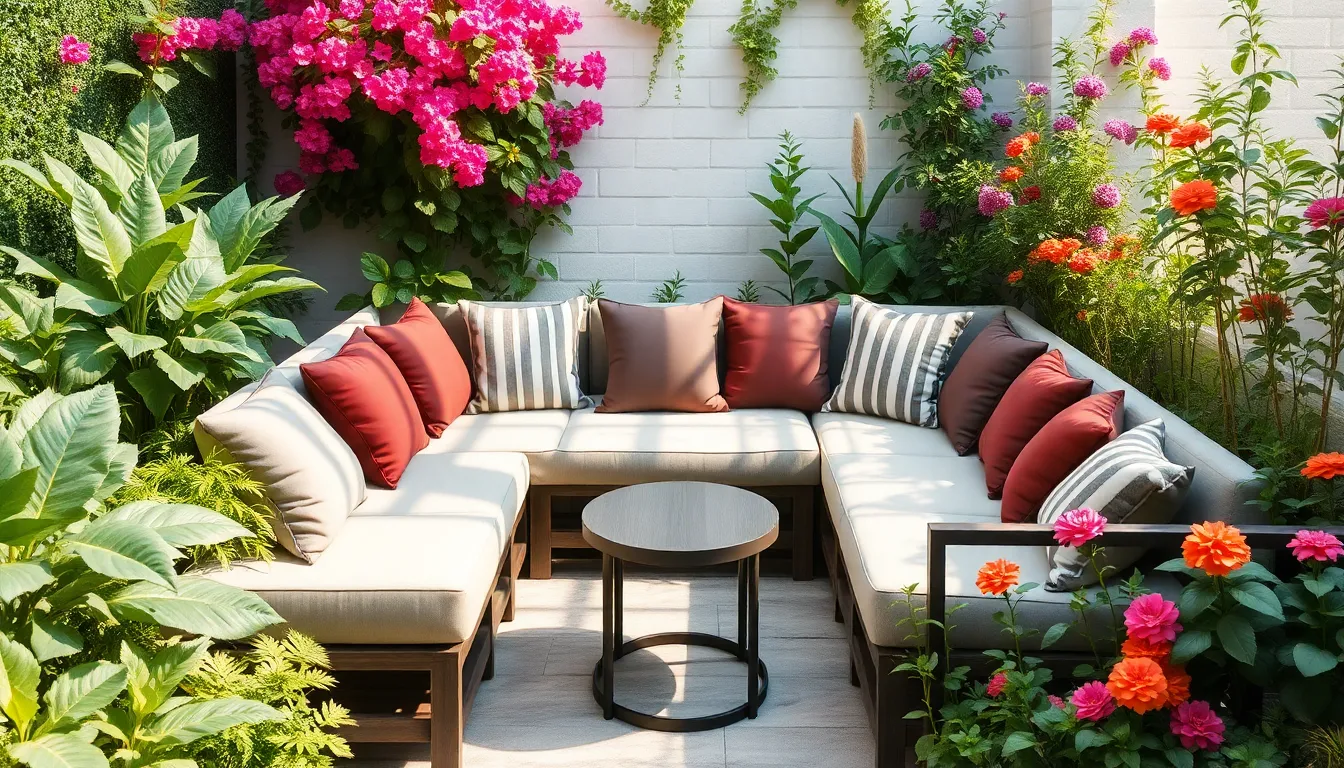
L-shaped seating arrangements transform forgotten garden corners into spacious social hubs that accommodate larger gatherings. We’ll explore how this versatile configuration maximizes both comfort and visual appeal in your outdoor space.
Position Along Two Garden Walls
Positioning your L-shaped sofa along two adjacent garden walls creates a natural cozy nook that feels both intimate and expansive. This strategic placement maximizes the corner area efficiently while providing ample seating for family and friends. We recommend measuring both walls carefully to ensure your furniture fits proportionally within the space.
Walls offer excellent support for cushions and backs while creating a sense of enclosure that enhances the overall garden ambiance. Built-in planters or decorative screens can extend from these walls to further define your seating area. Consider the sun patterns throughout the day when positioning your arrangement to ensure comfortable use during peak relaxation hours.
Mix Different Seating Heights
Different seating heights add visual interest and accommodate diverse comfort preferences within your L-shaped arrangement. We suggest incorporating standard chairs alongside stools or benches to create ever-changing layers that break up monotonous sight lines. This variety allows guests to choose their preferred seating position while contributing to a more organic, lived-in appearance.
Lower ottomans work exceptionally well as footrests or additional perching spots during larger gatherings. Taller bar-height stools can serve as convenient surfaces for drinks or books when not occupied. The key lies in balancing these heights so they complement rather than compete with your primary L-shaped structure.
Include Side Tables for Convenience
Side tables and coffee tables provide essential convenience by offering dedicated spaces for drinks, snacks, and personal items. We recommend placing at least one table within arm’s reach of each seating section to ensure all guests have easy access. Weather-resistant materials like teak, aluminum, or composite surfaces work best for these functional pieces.
Multiple smaller tables often prove more versatile than one large central table, allowing you to rearrange them based on your exact needs. Consider tables with lower shelves or built-in planters to maximize functionality while maintaining the garden theme. The right table placement enhances both comfort and the overall flow of your corner seating arrangement.
Install a Corner Pergola With Hanging Seats
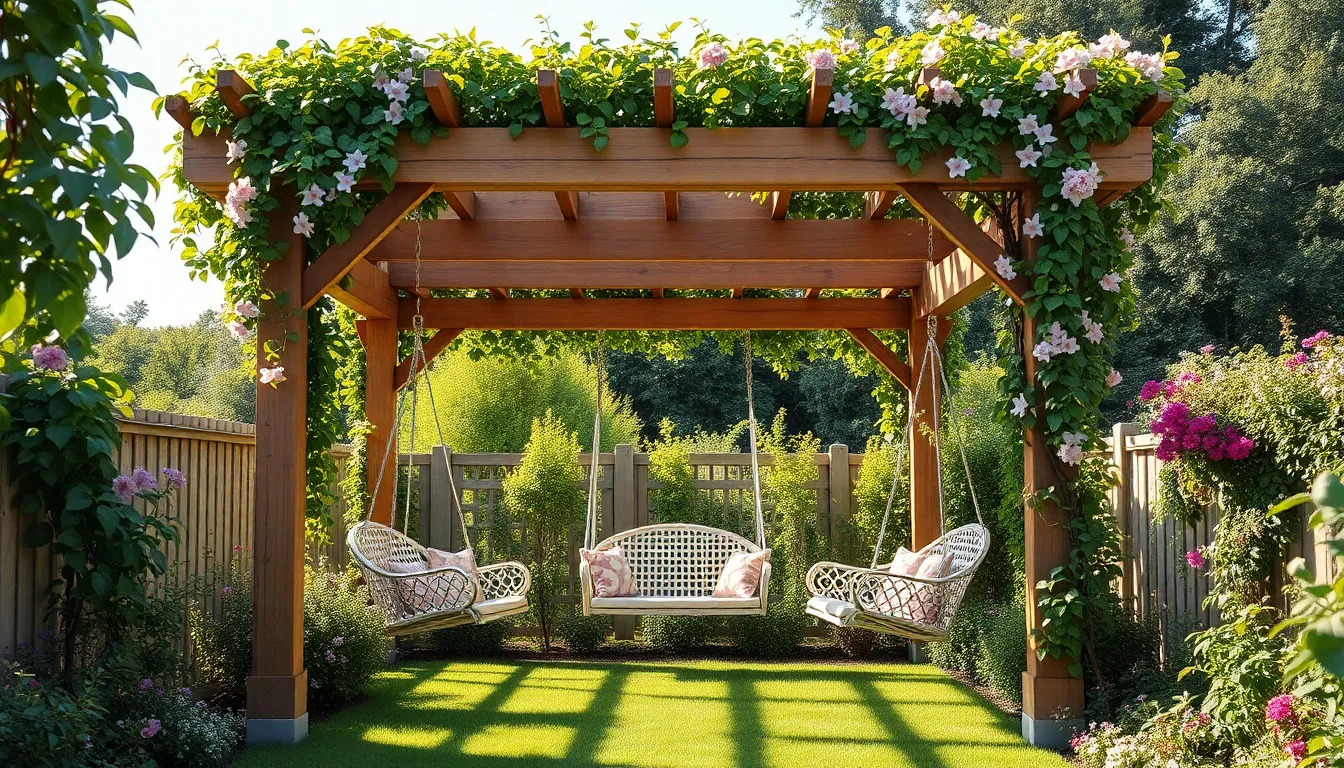
Adding a corner pergola with hanging seats creates an elegant focal point that transforms overlooked garden spaces into enchanting retreats. This structural approach combines architectural beauty with functional seating to maximize corner utilization.
Build a Sturdy Overhead Structure
Constructing a robust overhead framework serves as the foundation for your corner pergola seating area. We recommend using pressure treated lumber or aluminum posts rated for outdoor conditions to ensure long term stability. Cedar beams work exceptionally well for the horizontal framework since they naturally resist rot and insects while maintaining structural integrity.
Position the pergola posts at least 18 inches deep in concrete footings to withstand wind loads and the ever-changing forces from hanging seats. Space the overhead beams 16 to 24 inches apart to provide adequate support points for swing attachments. Install diagonal bracing between posts to prevent swaying and ensure the structure remains stable during use.
Weather resistant hardware becomes essential for connecting all structural components. Galvanized bolts and brackets resist corrosion while providing the strength needed for suspended seating installations. We suggest consulting local building codes to verify pergola height requirements and obtain necessary permits before construction begins.
Add Swing Chairs or Hammocks
Hanging seating options bring movement and comfort to your corner pergola while creating unique relaxation experiences. Swing chairs offer individual seating with gentle rocking motion that many find soothing after long days. We recommend choosing chairs with weather resistant cushions and sturdy chain or rope suspension systems rated for outdoor use.
Hammocks provide spacious lounging areas perfect for afternoon naps or reading sessions. Brazilian style hammocks work particularly well in corner installations since they accommodate the angular space efficiently. Install hammock hooks or eye bolts directly into the pergola’s structural beams using appropriate weight ratings for your chosen hammock style.
Consider installing multiple hanging seats at varying heights to accommodate different users and activities. Position swing chairs 3 to 4 feet apart to prevent collisions during use. We suggest adding side tables or hanging organizers nearby to hold books, drinks, and personal items while enjoying your suspended seating.
Incorporate Climbing Plants for Natural Shade
Climbing plants transform your corner pergola into a living structure that provides natural cooling and privacy enhancement. Grape vines create excellent overhead coverage while potentially producing edible fruit as an added benefit. We recommend fast growing varieties like Concord or Niagara grapes that adapt well to pergola training systems.
Flowering climbers such as clematis, jasmine, or climbing roses add seasonal color and fragrance to your corner retreat. These plants typically require 2 to 3 growing seasons to establish full coverage across pergola beams. Install wire grid systems or wooden lattice panels to guide plant growth and create uniform coverage patterns.
Evergreen options like ivy or Virginia creeper provide year round coverage and privacy screening. We suggest combining deciduous and evergreen climbers to maintain some winter structure while enjoying seasonal variety. Regular pruning keeps climbing plants healthy and prevents them from overwhelming the pergola framework or interfering with hanging seat mechanisms.
Construct a Raised Corner Deck With Seating
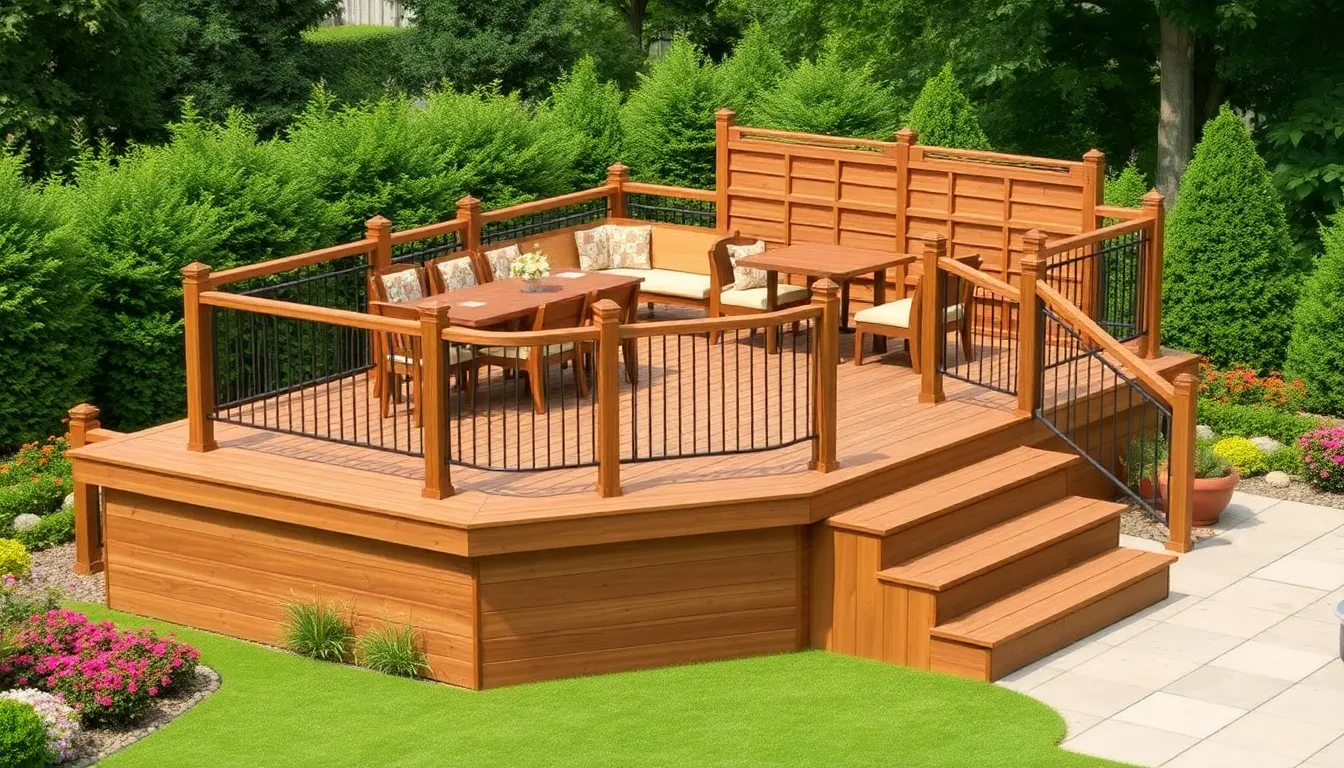
Elevated corner decking transforms underutilized garden spaces into commanding vantage points that offer panoramic views of your outdoor sanctuary. We’ll explore how raised platforms create distinct zones while maximizing both functionality and visual appeal.
Create Multi-Level Platform Areas
Tiered platforms establish distinct functional zones within your corner garden space, allowing you to separate dining areas from relaxation spots. We recommend constructing the highest level for dining tables and chairs, creating an elevated experience that feels restaurant-like. Lower tiers work perfectly for casual seating or as plant display areas, adding depth and visual interest to your corner design.
Planning each level’s purpose before construction ensures optimal space utilization and traffic flow. We suggest incorporating stairs or gentle ramps between levels to maintain accessibility for all family members. Strategic lighting placement on each tier extends usability into evening hours, making your multi-level corner deck a true 24-hour retreat.
Build Integrated Bench Seating
Built-in bench seating maximizes corner space efficiency while creating seamless design continuity throughout your elevated deck area. We recommend using materials like stone, cedar, or composite lumber that complement your existing garden aesthetic and withstand outdoor conditions. Corner benches can wrap around deck perimeters, providing ample seating without cluttering the platform with movable furniture.
Storage integration transforms basic bench seating into highly functional garden furniture that serves multiple purposes. We suggest incorporating hinged tops or side compartments within bench construction to store cushions, garden tools, or outdoor games. Weather-resistant hardware ensures these storage features remain functional throughout seasons while maintaining the bench’s structural integrity.
Add Railings for Safety and Style
Safety railings become essential elements when constructing raised corner decks, preventing accidents while adding architectural interest to your garden design. We recommend installing railings that meet local building codes for height and spacing requirements, typically 36 to 42 inches high with balusters spaced no more than 4 inches apart. Materials should match or complement your deck construction, whether using wood, metal, or composite options.
Decorative railing elements can enhance your corner deck’s visual appeal without compromising safety functions. We suggest incorporating planters, lighting fixtures, or artistic metalwork into railing designs to create custom features that reflect your personal style. Glass panels or cable railings maintain unobstructed garden views while providing necessary safety barriers for elevated seating areas.
Arrange Modular Outdoor Furniture Sets
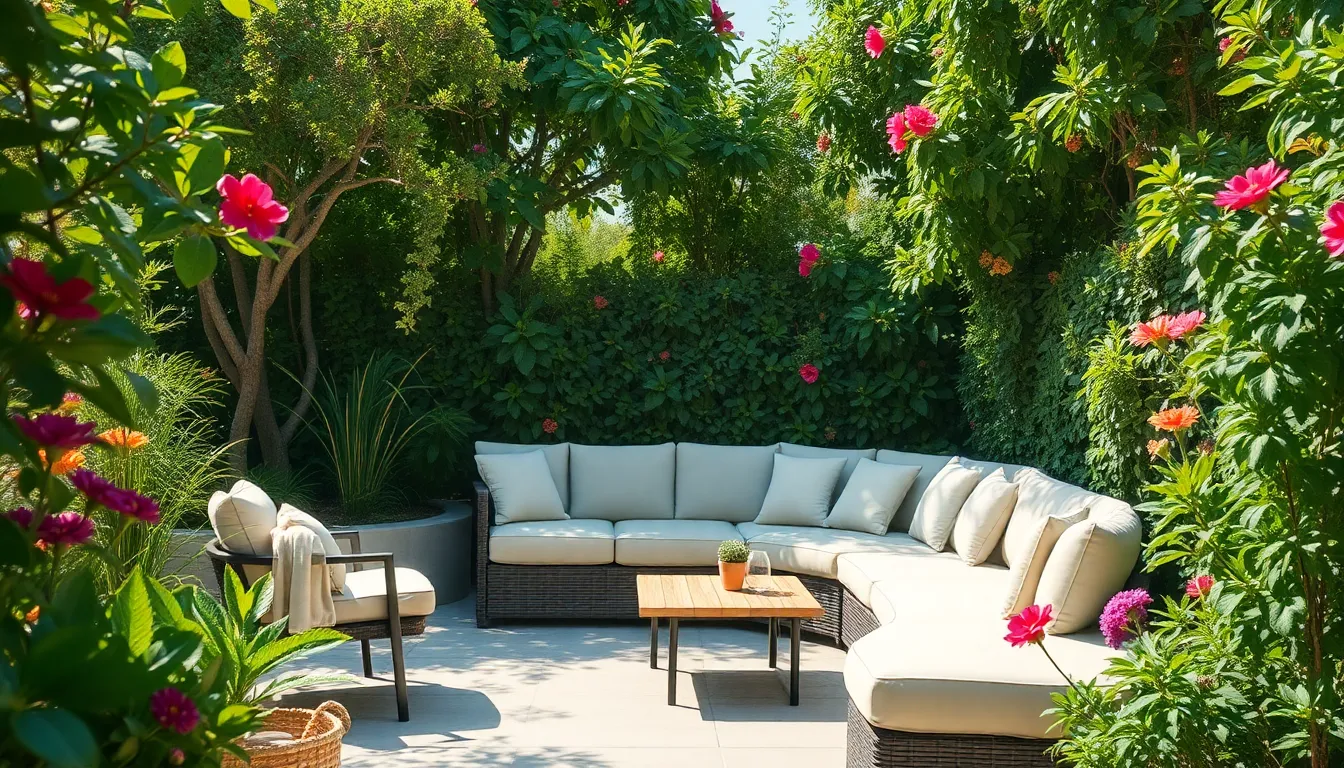
Modular outdoor furniture sets offer unparalleled flexibility for corner seating arrangements. We can create different seating configurations as needed while maximizing the potential of our garden corners.
Select Sectional Pieces That Fit Your Space
Sectional pieces should align perfectly with our garden’s exact dimensions to ensure optimal space utilization. We recommend measuring the corner area thoroughly before selecting any modular components. Corner sections work exceptionally well as anchor pieces, allowing us to build outward from the natural boundaries of our space.
Curved sectional pieces can soften harsh corner angles while maintaining the intimate feel of these tucked away areas. We find that choosing pieces with consistent proportions creates a cohesive look throughout the seating arrangement. Deep seated sections provide extra comfort for lounging, while narrower pieces work better in tighter corner spaces.
Choose Stackable or Foldable Options
Stackable seating options prove particularly valuable for small gardens where storage space remains limited. We can easily store these pieces during off-season months without sacrificing valuable garden real estate. Lightweight aluminum frames make stacking and moving furniture effortless for seasonal transitions.
Foldable chairs and ottomans offer instant flexibility when we need to reconfigure our corner seating for different occasions. Nested tables can slide under seating when not in use, keeping our corner area clean and spacious. Weather resistant folding mechanisms ensure these pieces maintain their functionality season after season.
Mix and Match Different Textures
Combining different textures like wood, rattan, and metal adds remarkable visual interest to our corner seating areas. We can pair wooden benches with metal accent chairs to create ever-changing contrast while maintaining design harmony. Rattan pieces bring natural warmth that complements both contemporary and traditional garden styles.
Woven textures work beautifully alongside smooth metal surfaces, creating tactile variety that enhances the overall sensory experience. We suggest incorporating soft fabric elements through cushions and throws to balance harder materials like steel or aluminum. Natural wood grains paired with sleek powder coated finishes create sophisticated layering that transforms simple corners into designer worthy retreats.
Build a Corner Fire Pit Seating Area
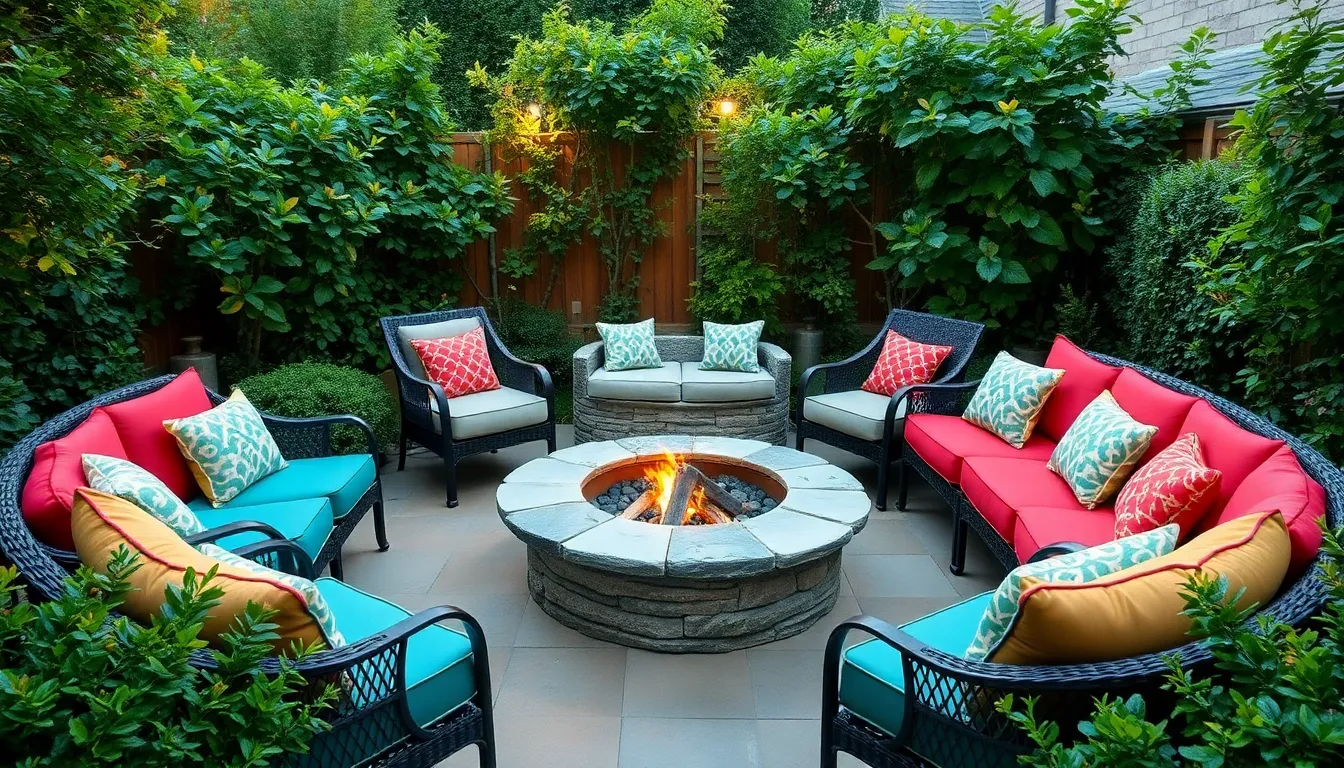
Creating a corner fire pit transforms your garden space into a year-round gathering spot that combines warmth with intimate conversation areas.
Design a Circular or Square Fire Feature
Circular fire pits work exceptionally well in corner spaces because they naturally draw people together in a social circle. We recommend positioning a 36-inch diameter fire pit approximately 3 feet from both corner walls to allow proper airflow and maintenance access. Round designs create a more intimate atmosphere and eliminate sharp edges that might pose safety concerns in tight spaces.
Square fire features offer a more structured aesthetic that complements modern garden designs. These geometric shapes fit naturally into corner layouts and provide multiple seating angles for larger gatherings. Consider a 30-inch square fire table that doubles as a surface for drinks and snacks when not in active use.
Gas fire pits provide instant flame control and eliminate the need for wood storage in your corner area. Electric options work well for smaller spaces and require minimal installation compared to permanent gas lines or wood burning alternatives.
Position Seating at Safe Distances
Maintain 6 to 8 feet between your fire pit and primary seating to ensure guest comfort without overheating. This distance allows people to enjoy the warmth while having comfortable conversations without raising their voices over crackling flames.
Arrange seating in a three quarter circle around the fire pit to maximize the corner space while keeping pathways open. Place your primary seating pieces like outdoor sofas or sectionals along the two corner walls, then add moveable chairs to complete the circle when hosting larger groups.
Consider multiple seating zones by creating a closer ring of fire resistant stools or benches at 4 feet for those who prefer more warmth, and a secondary zone of comfortable chairs at the recommended 8 foot distance. This arrangement accommodates different comfort preferences and creates visual depth in your corner layout.
Add Heat-Resistant Materials
Stone pavers or brick create the ideal foundation for your corner fire pit area because they withstand high temperatures and provide stable, level surfaces. Natural flagstone works particularly well in garden settings and develops an attractive patina over time from exposure to heat and weather.
Metal fire screens and spark guards protect your seating area from flying embers while maintaining the visual appeal of open flames. Stainless steel or wrought iron screens complement most garden styles and fold away when not needed.
Heat resistant seating materials like teak, aluminum, or powder coated steel ensure your furniture maintains its appearance even though exposure to radiant heat. Avoid plastic or synthetic wicker within 8 feet of the fire feature, as these materials can warp or discolor from prolonged heat exposure.
Create a Garden Corner Reading Nook
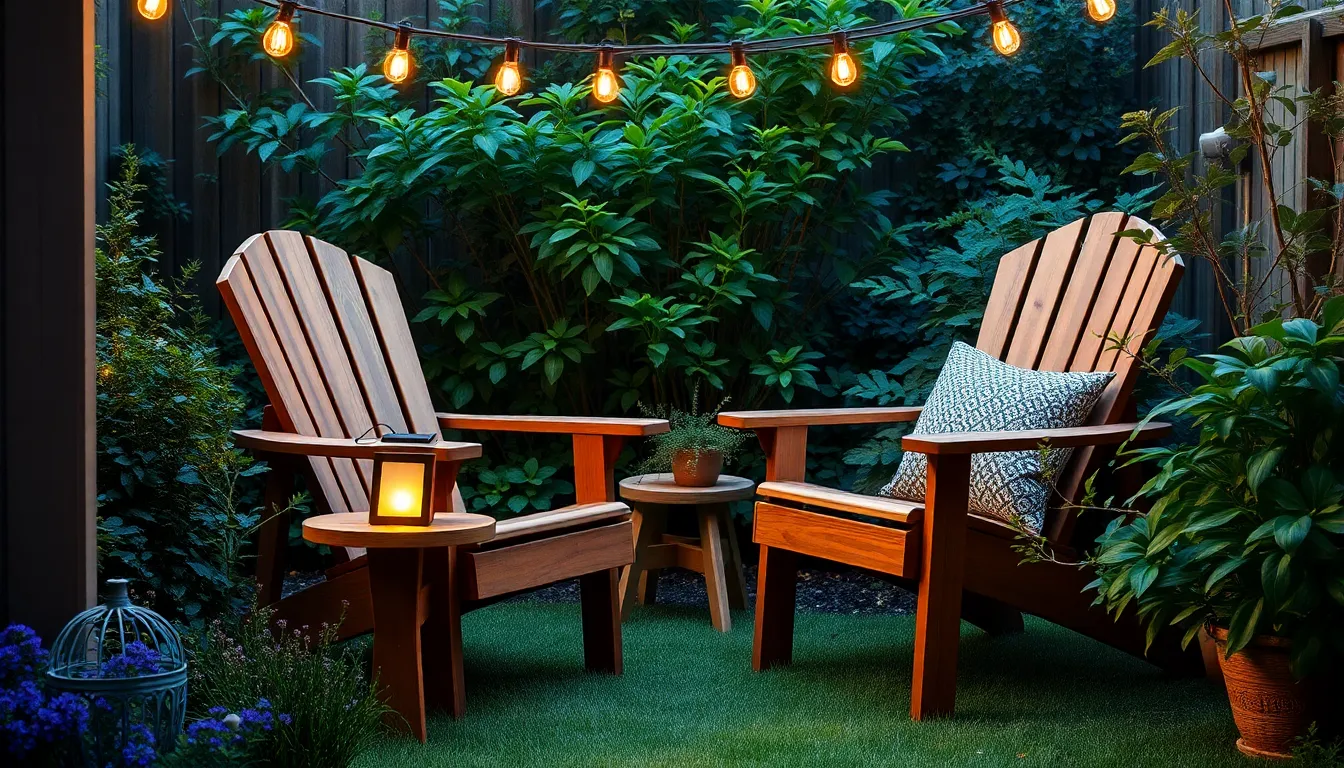
Transforming your garden corner into a personal reading sanctuary offers the perfect escape from daily distractions. This intimate space becomes your outdoor literary haven where pages turn naturally with gentle breezes.
Install a Single Comfortable Chair
Select weather resistant seating that supports extended reading sessions. Adirondack chairs provide classic comfort with their reclined angles and wide armrests that accommodate books and beverages. Teak outdoor loungers offer adjustable positioning to find your ideal reading angle while withstanding seasonal weather changes.
Position the chair to capture optimal natural light during your preferred reading hours. Morning readers benefit from east facing placement to catch gentle sunrise illumination, while afternoon enthusiasts should angle chairs toward filtered shade to avoid harsh glare on book pages.
Consider ergonomic features that enhance long term comfort. Chairs with lumbar support reduce back strain during extended reading periods, and models with wider seats accommodate various sitting positions for maximum relaxation.
Add a Small Side Table for Books
Choose compact side tables that complement your chair height and style. Tables measuring 16 to 18 inches wide provide sufficient surface area for stacking books, holding beverages, and storing reading accessories without overwhelming the corner space.
Incorporate storage features within the side table design. Models with lower shelves organize current reading materials and future book selections, while drawer compartments protect bookmarks, reading glasses, and outdoor cushions from weather exposure.
Select materials that match your garden’s aesthetic while ensuring durability. Cedar and teak side tables naturally weather to attractive gray patinas, while powder coated metal options maintain their appearance through multiple seasons with minimal maintenance requirements.
Include Adequate Lighting Options
Install solar powered reading lights that eliminate electrical installation requirements. These fixtures charge during daylight hours and automatically illuminate your reading nook at dusk, providing 6 to 8 hours of consistent lighting for evening reading sessions.
Position adjustable LED lanterns to reduce eye strain and enhance page visibility. Warm white lights between 2700K and 3000K create comfortable reading conditions while maintaining the cozy ambiance essential for outdoor relaxation spaces.
Incorporate string lights around the corner perimeter to establish ambient lighting boundaries. Battery operated LED strings offer flexible placement options and create a magical atmosphere that transforms your reading nook into an enchanting evening retreat.
Design a Corner Dining Space
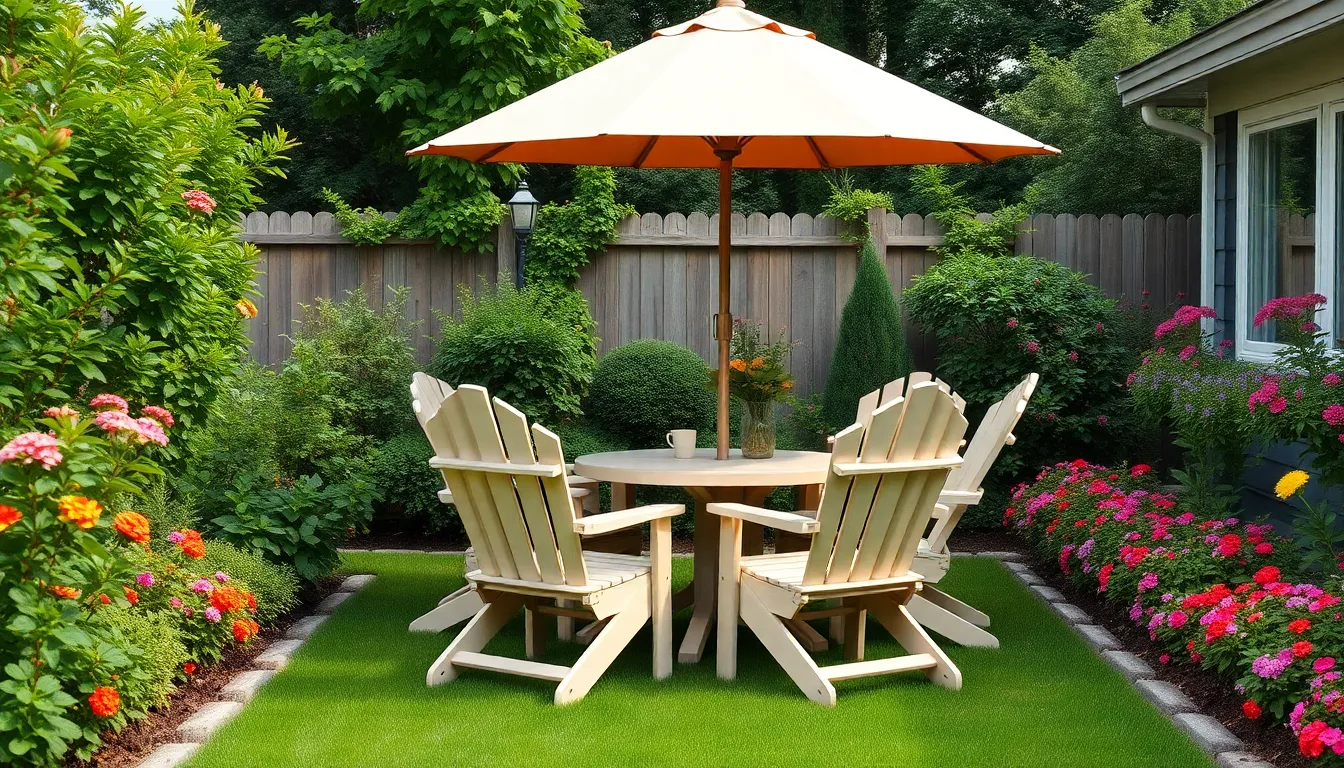
Corner dining spaces transform forgotten garden areas into functional outdoor rooms where families gather for memorable meals. We’ll show you how to create an inviting dining corner that maximizes your available space while maintaining comfort and style.
Choose a Round or Square Table
Corner dining tables fit snugly into tight spaces while providing ample surface area for meals and entertaining. We recommend selecting a table size that leaves at least 36 inches of clearance around all sides for comfortable chair movement.
Round tables work exceptionally well in corner settings because they eliminate sharp edges and create better traffic flow. They’re particularly effective when positioned at a 45-degree angle from the corner walls, allowing diners to face each other naturally.
Square tables maximize seating capacity in corner spaces and create a more structured dining arrangement. We suggest choosing square tables measuring 36 to 48 inches per side to accommodate four diners comfortably while fitting within most corner dimensions.
Bistro sets offer an excellent solution for smaller corner spaces, providing intimate dining for two people. These compact dining answers typically feature 24 to 30-inch round tops that don’t overwhelm tight quarters while still offering functional dining surfaces.
Select Comfortable Outdoor Chairs
Adirondack chairs create the perfect balance of comfort and durability for corner dining spaces. We position these classic chairs to face slightly inward, encouraging conversation while maintaining easy access to the dining table.
Wood benches maximize seating capacity along corner walls while providing a rustic charm that complements natural garden settings. Built-in corner benches can accommodate more diners than individual chairs and often include hidden storage compartments.
Stackable dining chairs offer flexibility for corner spaces that serve multiple purposes throughout the day. We recommend selecting chairs with arms for enhanced comfort during longer meals and weather-resistant cushions for added softness.
Mixed seating arrangements combine different chair styles to create visual interest and accommodate various comfort preferences. Pairing two chairs with a corner bench creates an L-shaped seating configuration that maximizes both comfort and space efficiency.
Add an Umbrella or Shade Structure
Market umbrellas provide essential shade protection for corner dining spaces while adding vertical visual interest. We recommend choosing umbrellas with 8 to 10-foot canopies to adequately cover most corner dining setups without overwhelming the space.
Cantilever umbrellas work particularly well in corner locations because their offset design doesn’t interfere with table placement or chair movement. These umbrellas can be positioned beside the dining area rather than through the table center, offering more flexible shade coverage.
Wall-mounted pergolas create permanent shade structures that define corner dining spaces while adding architectural interest. We suggest installing pergolas with retractable canopies or climbing vines to provide adjustable shade throughout different seasons.
Shade sails offer a modern alternative to traditional umbrellas, stretching between corner walls and nearby support posts. These triangular or rectangular fabric panels provide excellent sun protection while creating contemporary visual appeal that complements modern garden designs.
Install Corner Built-In Planters With Seating
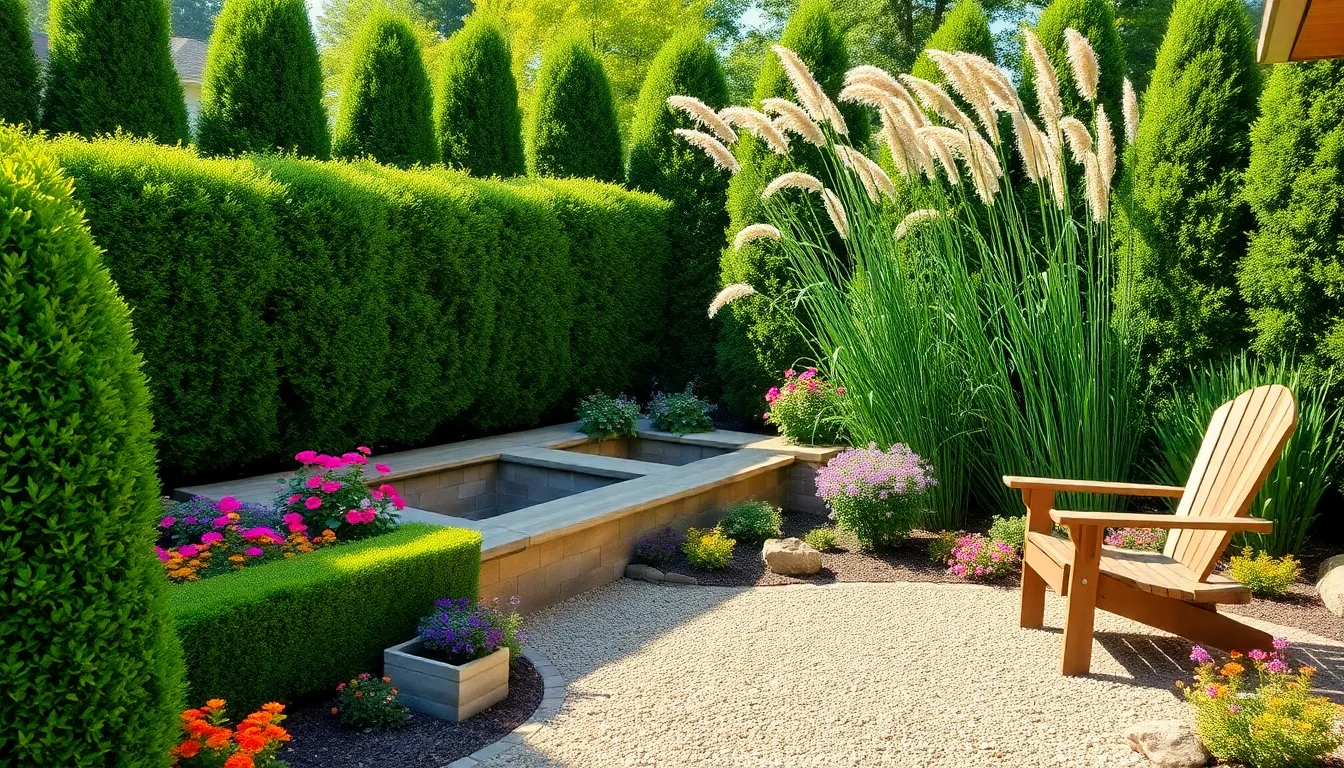
Built-in planters with integrated seating create the perfect dual-purpose solution for maximizing corner spaces. These installations transform forgotten garden areas into productive and comfortable zones that serve multiple functions simultaneously.
Combine Seating With Garden Beds
Stone benches positioned directly adjacent to flower gardens create an inviting atmosphere that encourages daily interaction with your plants. We recommend placing these seating elements at strategic viewing angles where you can appreciate seasonal blooms and monitor plant health easily.
Raised planter walls that double as bench backs provide comfortable support while creating distinct garden zones. These elevated structures work particularly well with depths of 18-24 inches, allowing space for both shallow and deep-rooted plants behind your seating area.
Adirondack chairs nestled between herb gardens and vegetable plots offer flexible seating that moves with seasonal planting needs. We suggest positioning these chairs on gravel or stone pads to prevent sinking while maintaining easy repositioning capabilities.
Built-in concrete or stone seating that incorporates planting pockets maximizes every square foot of corner space. These permanent installations can include drainage systems and irrigation lines for effortless plant maintenance.
Choose Plants That Provide Privacy
Hedge plantings like boxwood and privet create natural privacy screens that mature into dense barriers around corner seating areas. We recommend spacing these plants 18-24 inches apart for optimal coverage within 2-3 growing seasons.
Tall ornamental grasses such as fountain grass and pampas grass provide instant privacy while adding movement and texture to corner spaces. These plants typically reach 4-6 feet in height and require minimal maintenance once established.
Evergreen shrubs including juniper and arborvitae offer year-round screening that protects corner seating from wind and neighboring views. We suggest selecting varieties that won’t exceed your desired height at maturity to avoid constant pruning.
Climbing plants trained on trellises or arbors create vertical privacy walls that don’t consume valuable floor space. Clematis, morning glory, and climbing roses work exceptionally well for corner installations where ground space is limited.
Create Multi-Functional Design Elements
Storage benches with hinged tops provide comfortable seating while concealing garden tools, cushions, and outdoor supplies. We recommend cedar or composite materials that resist moisture and insects for long-lasting functionality.
Fire pit seating combinations transform corner areas into year-round gathering spaces that extend outdoor living seasons. These installations work best with circular arrangements that accommodate 4-6 people comfortably around a central fire feature.
Integrated lighting within planter walls and bench structures extends usability into evening hours while highlighting plantings and architectural features. Solar-powered LED strips and spotlights offer energy-efficient illumination without electrical installation requirements.
Built-in side tables attached to planter walls or bench arms provide convenient surfaces for drinks, books, and garden supplies. We suggest incorporating weather-resistant materials like teak, stainless steel, or sealed concrete that complement your overall design aesthetic.
Conclusion
We’ve shown you how those forgotten garden corners can become the most cherished spots in your outdoor space. From cozy reading nooks to entertaining fire pit areas these transformations don’t require massive budgets or extensive renovations.
The key lies in understanding your space and choosing answers that match your lifestyle. Whether you opt for built-in storage benches or modular furniture sets each approach offers unique benefits that enhance both function and beauty.
Your garden corners are waiting to become something special. With the right seating arrangement proper materials and thoughtful design elements you’ll create outdoor retreats that invite relaxation and bring people together naturally.
Frequently Asked Questions
What are the best materials for outdoor corner seating?
Weather-resistant materials like cedar, teak, composite lumber, aluminum, and powder-coated steel are ideal for outdoor corner seating. These materials withstand harsh weather conditions while maintaining their appearance. Cedar and teak offer natural beauty and durability, while composite lumber requires minimal maintenance. Metal options like aluminum and powder-coated steel provide modern aesthetics and exceptional longevity.
How can I maximize storage in my corner garden seating?
Incorporate built-in storage compartments with hinged seat tops and side compartments within your corner bench design. These hidden storage areas can hold garden tools, cushions, and outdoor supplies while maintaining the seating’s aesthetic appeal. Consider lift-up seats and hollow bench bases to maximize storage capacity without compromising comfort or style.
What’s the ideal size for a corner fire pit seating area?
Maintain at least 6-8 feet between seating and the fire pit for safety and comfort. Arrange seating in a three-quarter circle to maximize space while ensuring everyone can enjoy the warmth. The fire pit itself should be 30-36 inches in diameter for optimal airflow and heat distribution, with heat-resistant materials for both seating and surrounding flooring.
How do I create the perfect garden corner reading nook?
Select weather-resistant seating like Adirondack chairs or teak loungers positioned to capture optimal natural light. Add a small side table for books and beverages, incorporate storage features for reading materials, and install adequate lighting such as solar-powered reading lights or adjustable LED lanterns. String lights can create ambient lighting for evening reading sessions.
What shade options work best for corner dining spaces?
Market umbrellas, cantilever umbrellas, wall-mounted pergolas, and modern shade sails are excellent options for corner dining areas. Market umbrellas offer traditional charm and easy adjustment, while cantilever umbrellas provide unobstructed table space. Wall-mounted pergolas maximize corner space efficiency, and shade sails add contemporary style while offering flexible coverage options.
How can I incorporate plants into my corner seating design?
Create built-in planters with integrated seating by combining stone benches with adjacent flower gardens. Use raised planter walls that double as bench backs, or install built-in concrete seating with planting pockets. Consider hedge plantings, tall ornamental grasses, evergreen shrubs, and climbing plants on trellises to enhance privacy and create a natural, inviting atmosphere.
What are the benefits of modular furniture for corner spaces?
Modular outdoor furniture offers flexibility for corner seating arrangements, allowing you to reconfigure pieces as needed. Sectional pieces can be arranged to fit your garden’s specific dimensions, while curved sections help soften harsh corner angles. For smaller gardens, stackable and foldable options provide easy storage and space-saving solutions when not in use.
How do I design an L-shaped seating arrangement for my garden corner?
Position the L-shaped seating along two adjacent garden walls to create a cozy, intimate nook that feels spacious. Mix different seating heights to add visual interest and accommodate various comfort preferences. Include side tables for drinks and snacks, and ensure the arrangement allows for easy conversation while maximizing the corner space efficiently.

